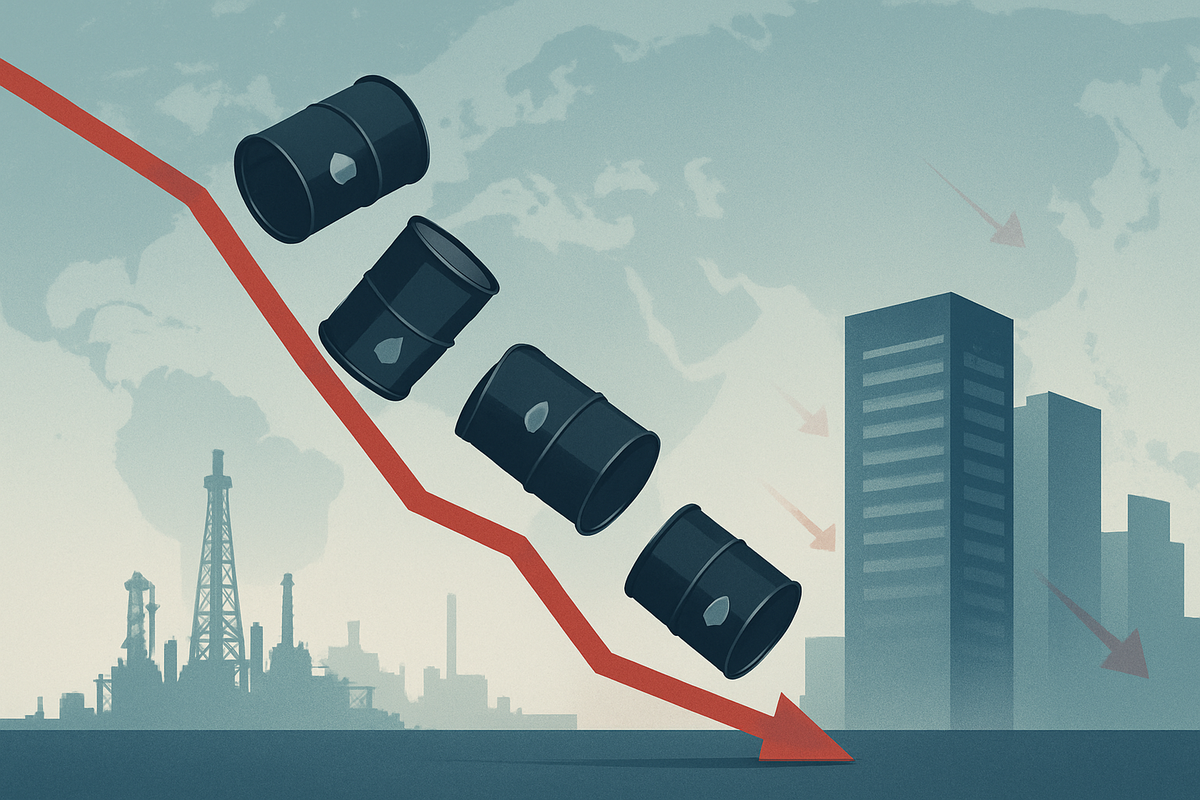
The global energy markets are currently experiencing a significant period of volatility, marked by a general weakening in crude oil prices that is sending ripples through the financial performance and strategic outlooks of major players like ExxonMobil. As of October 31, 2025, a confluence of factors, including a strengthening U.S. dollar, concerns over sluggish global demand, and anticipated oversupply, has pushed crude benchmarks into a third consecutive monthly decline. This downturn is forcing energy companies to re-evaluate their operational efficiencies, investment priorities, and long-term growth trajectories in an increasingly unpredictable landscape.
While the immediate implication is a direct hit to revenues and profits for upstream operations, the situation also underscores a broader industry trend towards resilience and strategic adaptation. Companies are leveraging robust cash flows from previous high-price cycles, implementing stringent cost-cutting measures, and pursuing targeted growth in high-value assets and diversified energy sources to weather the storm. The current environment is not merely a transient dip but a potential catalyst for accelerated transformation within the energy sector, challenging traditional business models and rewarding agility.
The Shifting Sands of Oil and Gas Markets
The current commodity pricing environment presents a stark picture, particularly for crude oil. West Texas Intermediate (WTI) crude has fallen to approximately $60.39 USD per barrel, reflecting a multi-month decline and a significant drop year-over-year. Similarly, Brent crude futures are trading around $64.74 a barrel, also experiencing a downward trend. This sustained weakness is primarily attributed to a stronger U.S. dollar, which makes oil more expensive for international buyers, coupled with persistent concerns over weak global demand—especially from manufacturing hubs like China, which has seen contracting activity for seven consecutive months. Adding to the bearish sentiment is the expectation of increased output from OPEC+ nations, potentially leading to an oversupplied market, and a continuous build-up in U.S. inventories, as projected by the U.S. Energy Information Administration (EIA).
In contrast, natural gas markets exhibit a more nuanced and geographically divergent trend. European natural gas (TTF) prices have declined, influenced by moderate mid-autumn demand and ample Liquefied Natural Gas (LNG) supply, despite minor recent disruptions. However, U.S. natural gas futures have surged, reaching a six-month high of $4.116 per million British thermal units (MMBtu). This uptick in the U.S. is fueled by near-record LNG export flows, a slight reduction in domestic gas output, and forecasts of colder weather, which are expected to boost heating demand in key regions. The disparity highlights the localized dynamics that can influence commodity prices, even within the broader energy sector. Key players include global economic powerhouses whose industrial output dictates demand, OPEC+ members who influence supply, and major energy companies like ExxonMobil (NYSE: XOM) that navigate these fluctuating price environments. The initial market reaction has been one of cautious adjustment, with companies emphasizing cost control and strategic project execution.
Energy Giants Face the Headwinds
Major integrated energy companies are at the forefront of feeling the impact of these weak commodity prices. ExxonMobil (NYSE: XOM), one of the world's largest publicly traded international energy companies, provides a clear illustration of this challenge. For the third quarter of 2025, ExxonMobil reported earnings of $7.5 billion, or $1.76 per share, slightly missing analyst estimates. Quarterly revenue came in at $87.7 billion, largely in line with expectations, though some reports cited a slightly lower figure of $85.3 billion. More significantly, the company's year-to-date earnings declined to $22.3 billion from $26.1 billion in the previous year. This reduction is primarily attributed to weaker crude prices, along with bottom-of-cycle chemical margins and increased depreciation costs, particularly affecting its Upstream and Chemical Products segments.
Despite these headwinds, ExxonMobil's management, led by CEO Darren Woods, has highlighted the company's resilience, noting that Q3 2025 achieved its "highest earnings per share we've had compared to other quarters in a similar oil-price environment." This performance is credited to strong operational execution and strategic growth initiatives. The company generated a robust $14.8 billion in cash flow from operations and $6.3 billion in free cash flow, enabling it to return $9.4 billion to shareholders through dividends and share repurchases. Notably, ExxonMobil announced a 4% increase in its fourth-quarter dividend, extending its impressive streak of annual dividend growth to 43 years.
To navigate the challenging pricing environment, ExxonMobil is aggressively pursuing a multi-pronged investment strategy. This includes achieving new production records in Guyana and the Permian Basin, expanding its Permian holdings through acquisitions, and integrating Pioneer Natural Resources Co. (NYSE: PXD) to significantly boost production capacity. The company is also relentless in its focus on cost efficiency, having exceeded $14 billion in cumulative structural cost savings since 2019, with a target of over $18 billion by 2030. Furthermore, ExxonMobil is diversifying into lower-carbon energy platforms such as hydrogen, carbon capture and storage, biofuels, and lithium, aiming to generate more predictable revenues from long-term contracts and reduce earnings volatility, with plans to invest approximately $140 billion into major projects and its Permian Basin development program by 2030.
Broader Implications and Industry Trends
The current slump in crude oil prices, juxtaposed with the varied performance of natural gas, is not an isolated incident but rather fits into broader industry trends and geopolitical dynamics. The global push towards energy transition and decarbonization continues to exert long-term pressure on fossil fuel demand, even as immediate energy security concerns remain paramount. This environment forces energy companies to balance short-term profitability with long-term sustainability goals. The ripple effects extend beyond the integrated majors to the entire energy ecosystem, impacting oilfield service companies, equipment manufacturers, and even national economies heavily reliant on oil exports. Smaller, less diversified producers may find it increasingly difficult to sustain operations or secure financing in a low-price environment, potentially leading to industry consolidation.
Historically, the energy market has been characterized by cyclical booms and busts. Periods of weak commodity pricing, such as the mid-1980s, late 1990s, and mid-2010s, have often triggered significant restructuring, technological innovation, and a renewed focus on cost discipline within the industry. Today's scenario mirrors these historical precedents in its demand for efficiency and strategic foresight, but it is also unique due to the accelerating energy transition and heightened climate policy scrutiny. Regulatory and policy implications are also significant; governments may face pressure to intervene through strategic petroleum reserve releases or production quotas to stabilize markets, while climate policies continue to shape investment decisions towards lower-carbon solutions.
The Path Forward: Adaptation and Innovation
Looking ahead, the energy market faces a complex interplay of forces that will dictate short-term and long-term outcomes. The EIA projects Brent crude to average around $62 a barrel in late 2025, suggesting a continued period of subdued prices. However, geopolitical events, OPEC+ decisions, and the pace of global economic recovery could swiftly alter this trajectory. For energy companies, strategic pivots are not just an option but a necessity. This includes a continued emphasis on capital efficiency, prioritizing "advantaged projects" with low costs of supply, and leveraging technological advancements to optimize existing operations.
The current environment also presents both market opportunities and challenges. Consolidation within the upstream sector may accelerate as stronger players acquire distressed assets, leading to a more streamlined and efficient industry. Companies that have successfully diversified their portfolios into renewables, carbon capture, or other lower-carbon technologies are better positioned to mitigate volatility and capture new growth avenues. Potential scenarios range from a gradual recovery in crude prices driven by unexpected demand surges or supply disruptions, to a prolonged period of lower prices that further accelerates the energy transition. The ability of companies to adapt their business models, invest wisely, and maintain financial discipline will be crucial for navigating these evolving dynamics.
Navigating a Transformed Energy Landscape
In summary, the current weak commodity pricing, particularly in crude oil, is a significant market event that is profoundly impacting major energy companies like ExxonMobil. While facing revenue and profit pressures, these companies are demonstrating remarkable resilience through aggressive cost-cutting, strategic acquisitions, and a focused approach to high-value production. ExxonMobil's ability to maintain strong cash flow, increase shareholder returns, and invest in both traditional and lower-carbon energy projects underscores a broader industry shift towards operational excellence and diversification.
Moving forward, the energy market will remain highly sensitive to global economic health, geopolitical developments, and the ongoing pace of the energy transition. Investors should closely watch for continued financial discipline from energy companies, their progress on structural cost savings, and the successful execution of growth projects in key basins like the Permian and Guyana. Furthermore, the strategic deployment of capital into lower-carbon solutions will be a key indicator of long-term viability and adaptability. The current period of market softness is not just a challenge but an accelerant for innovation, demanding that energy giants become more agile, efficient, and forward-thinking to thrive in a transformed global energy landscape.
This content is intended for informational purposes only and is not financial advice






